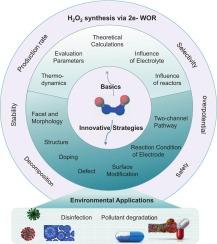Innovative strategies on electrocatalysts for H2O2 synthesis by water oxidation: from basics to environmental applications
IF 23.5
1区 化学
Q1 CHEMISTRY, INORGANIC & NUCLEAR
引用次数: 0
Abstract
Electrochemical synthesis of hydrogen peroxide (H2O2) has been widely considered as an alternative to anthraquinone process due to its safety, feasibility and affordability. The two-electron water oxidation reaction (2e− WOR) usually possesses superior potential for electrochemical H2O2 generation than the two-electron oxygen reduction reaction (2e− ORR), because the former can avoid the low concentration and poor mass transfer of O2 and can provide sufficient oxygen element supply. However, the 2e− WOR faces the challenge of competition between 4e− WOR (selectivity), low efficiency and H2O2 decomposition. Also, the mechanisms and the key parameters influencing the 2e− WOR are not clear. In this review, we will focus on how to improve the selectivity and activity of 2e− WOR, how to avoid and evaluate the decomposition of H2O2, and what will influence the mechanisms for 2e− WOR. The basics of H2O2 synthesis by water oxidation are systematically overviewed, including thermodynamics, fundamental evaluation parameters, theoretical calculations, decomposition of H2O2, the influence of electrolyte and electrochemical reactors on 2e− WOR. Most importantly, various innovative strategies on electrocatalysts are summarized, mainly involved in morphology and facet regulation, structure optimization, doping engineering, defect introduction, surface modification, dual-active-site strategy, reaction condition optimization of electrodes, and construction of dual two-channel pathway. The approaches for inhibiting H2O2 decomposition are reviewed, such as the addition of H2O2 stabilizer and bubble shielding method. Afterward, the environmental applications of H2O2 in disinfection and pollutant degradation are firstly reviewed. Finally, future challenges and opportunities towards H2O2 by 2e− WOR are presented, which can inspire us for future development of 2e− WOR.

水氧化合成H2O2电催化剂的创新策略:从基础到环境应用
电化学合成过氧化氢(H2O2)因其安全性、可行性和经济性而被广泛认为是替代蒽醌法的一种方法。双电子水氧化反应(2e - WOR)通常比双电子氧还原反应(2e - ORR)具有更强的电化学生成H2O2的潜力,因为前者可以避免O2浓度低、传质差的问题,并能提供足够的氧元素供应。然而,2e - WOR面临着4e - WOR(选择性)、低效率和H2O2分解的竞争挑战。此外,影响2e - WOR的机制和关键参数也不清楚。本文就如何提高H2O2 - WOR的选择性和活性,如何避免和评价H2O2的分解,以及影响H2O2 - WOR的机制等方面进行了综述。系统综述了水氧化法合成H2O2的基本原理,包括热力学、基本评价参数、理论计算、H2O2的分解、电解液和电化学反应器对2e - WOR的影响。最重要的是,总结了电催化剂的各种创新策略,主要涉及形貌和facet调节、结构优化、掺杂工程、缺陷引入、表面修饰、双活性位点策略、电极反应条件优化、双双通道通道构建等。综述了抑制H2O2分解的方法,如添加稳定剂和气泡屏蔽法。随后,综述了H2O2在消毒和污染物降解方面的环境应用。最后,提出了未来2e - WOR对H2O2的挑战和机遇,为2e - WOR的未来发展提供启示。
本文章由计算机程序翻译,如有差异,请以英文原文为准。
求助全文
约1分钟内获得全文
求助全文
来源期刊

Coordination Chemistry Reviews
化学-无机化学与核化学
CiteScore
34.30
自引率
5.30%
发文量
457
审稿时长
54 days
期刊介绍:
Coordination Chemistry Reviews offers rapid publication of review articles on current and significant topics in coordination chemistry, encompassing organometallic, supramolecular, theoretical, and bioinorganic chemistry. It also covers catalysis, materials chemistry, and metal-organic frameworks from a coordination chemistry perspective. Reviews summarize recent developments or discuss specific techniques, welcoming contributions from both established and emerging researchers.
The journal releases special issues on timely subjects, including those featuring contributions from specific regions or conferences. Occasional full-length book articles are also featured. Additionally, special volumes cover annual reviews of main group chemistry, transition metal group chemistry, and organometallic chemistry. These comprehensive reviews are vital resources for those engaged in coordination chemistry, further establishing Coordination Chemistry Reviews as a hub for insightful surveys in inorganic and physical inorganic chemistry.
 求助内容:
求助内容: 应助结果提醒方式:
应助结果提醒方式:


